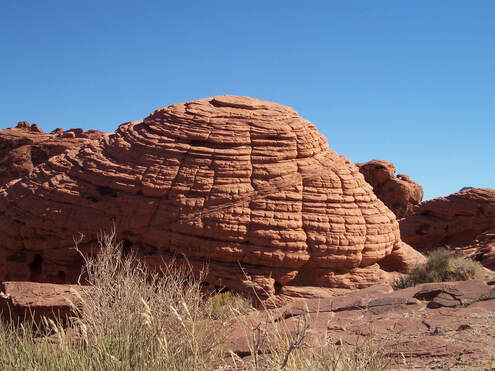 Beehives rock formation at Valley of Fire State Park, Nevada Beehives rock formation at Valley of Fire State Park, Nevada Thinking of escaping to Las Vegas any time soon? While it’s fun to take in a glamorous show or two and try your luck with the one-armed bandits, after a while you’ll want an activity that won’t blow your budget. Fortunately, you’ll find it not far from Sin City—at Valley of Fire State Park. When you’re ready to strap on some light-weight hiking gaiters and get some exercise, be sure to tank up, slather on sunscreen, and head into the Mojave Desert. It’s not too far to drive, and just right for a day trip. Once voted “Best Scenic Drive in Southern Nevada” by readers of Nevada Magazine, Interstate 15 (Valley of Fire State Park Scenic Byway) takes you 55 miles northeast of Las Vegas to Nevada’s oldest state park. Although the Strip’s neon tubes are missing here, brilliant colors are not. Shades of deep red, brown, and orange seem to glow even more vividly at sunrise and sunset, thus the name Valley of Fire. The park was dedicated in 1935, but its sandstone formations were formed some 150 million years ago from vast shifting sand dunes. The modest Visitor Center is the best place to learn more about the geology, ecology, and history of the park and the nearby region, so stop in for a brochure. Several scenic roads wind throughout the park, each one leading to yet another unique feature— petrified logs, dramatic rock outcroppings, and ancient petroglyphs. Eroded by wind, water, and time, the Beehives and Rainbow Vista are especially impressive. The White Domes Road ends at a stately formation of sparkling white rock. Be sure to stop at Atlatl Rock to see 3,000 year-old Indian rock art up close. An atlatl, the predecessor to the modern bow and arrow, was a notched stick used to throw primitive spears. You’ll see this tool clearly depicted among the well-preserved petroglyphs. Atlatl Rock is also a nice shaded spot for a picnic. To stretch your legs, take one of the many hiking trails that lead to even more amazing sandstone formations. Don’t miss Mouse’s Tank. Named for a renegade murder suspect who hid out here in the 1890s, Mouse’s Tank is a natural basin where rainwater collects. A scramble up the rocks provides a nice bird’s eye view, but the best part for history buffs is the numerous petroglyphs etched into the boulders that flank this half-mile sandy trail— evidence that the area has been visited for thousands of years. Keep your eyes open because chuckwallas and collared lizards often scamper out of the shady rock crevices. Snake gaiters are a good idea, too. And of course, take plenty of water.Comments are closed.
|
RAZER GAITERS
 RSS Feed
RSS Feed
